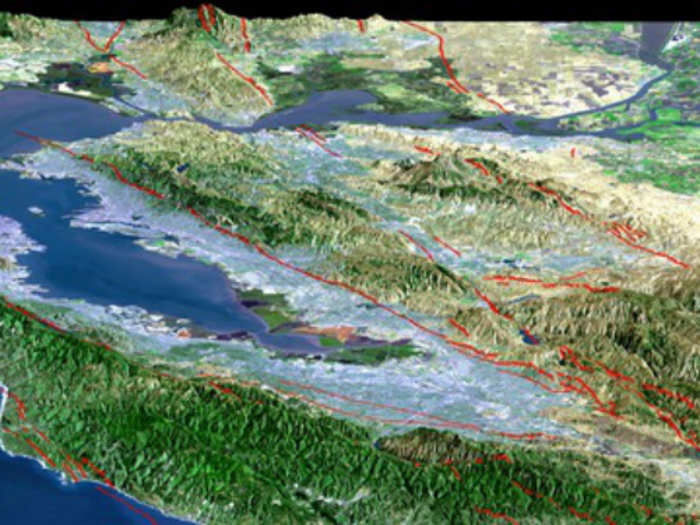
The well-known San Andreas Fault is just one of the seven "significant fault zones" the US Geological Survey cites in the Bay Area. The others are the Calaveras, Concord-Green Valley, Greenville, Hayward, Rodgers Creek, and San Gregorio Faults.
People who live in the area experience small earthquakes and shakes all the time. Just this week, there has been a 2.9 and a 3.0-sized shake in Aromas, California, about an hour and 40 minutes south of the city.

In 2007, the USGS determined that there's about a "63% probability of a magnitude 6.7 or greater earthquake in the Bay Area" by 2037.
Estimates have only gotten worse since then. One recent report suggests that there's a 76% chance the Bay Area will experience a magnitude 7.2 earthquake some time in the next 30 years.

Anything higher than a 7.9 on the San Andreas Fault line, which runs from Mendocino down to Mexico, would put "approximately 100%" of the population of San Francisco at risk, while a 6.9 quake from the Hayward Fault could spell trouble for nearly everyone who lives and works there, according to the city.

The Earth is turning a little slower than usual right now, which puts extra squeeze on tectonic plates, and may mean more high-magnitude shakes are on the way.

Old 19th century trash that was dumped out to widen the city could quickly level the bottoms of many homes during a big quake. It already did once in 1989.
Experts estimate that places like the Marina neighborhood, pictured above, would today be 50% destroyed by anything higher than a 7.2 magnitude earthquake on the San Andreas Fault.

That's less likely than a Californian earthquake, because typically, tsunami waves aren't super-serious once they reach San Francisco's shores. According to the city, most of the tsunamis that hit the Bay Area from Alaskan earthquakes are less than a foot high by the time they make landfall.
But, there's still a chance that a tsunami moving in from the Cascadia subduction zone further north could come into the Bay Area at more than 16 feet high, UC Santa Cruz earth sciences professor Steven Ward told KQED.

Thankfully, the city itself isn't perpetually threatened by wildfires, like much of the rest of the state. But the nearby vineyards of Napa Valley did not escape the 2017 wildfire season unscathed.

Many people in San Francisco took to wearing masks so they wouldn't have to breathe the smoky fumes wafting in.

East Bay resident Will Wright, who had a near-death experience when his home burned to the ground, was inspired by the tragedy to create the wildly popular game "The Sims," according to local news site Berkeleyside.

Researchers estimate that by the year 2100 the sea will rise an average of between four and five feet in the the Bay Area, putting the current headquarters of Silicon Valley companies like Facebook and Yahoo underwater, if nothing more is done to mitigate the effects of climate change.
In the city, sea levels are expected to rise 66 inches by 2100. That's five and a half feet.

The natural caving-in process at work is called "subsidence," and it's happening because the city is built on heaps of trash and Holocene-era mud that's slipping away.

"Severe storms can cause landslides, coastal flooding, and stormwater ponding," the city warns.
Scientists predict we'll see many more of those kinds of events in the coming years, as more "surprise" and potentially irreversible climate events crop up around the globe.

The Bay Area, like much of California, is "abnormally dry" this spring, SF Gate reports, though the maps are getting better with each passing week.
Still, supplying Californians with enough water to live is increasingly becoming an expensive problem. The Pacific Institute estimates that municipal water costs in California metro areas rose at two to three times the rate of inflation between 2000-2010.

With extreme weather events and heat waves on the rise around the world, people in San Francisco may have a tougher time than other Americans finding relief from scorching temperatures at home, at least in the near future.
According to the 2011 housing survey of the US Census, "the Bay Area had the lowest percentage of housing units with central air conditioning (10%) of any region in the country," the San Francisco Business Times reports. That compares with 66% of people nationwide who said they have central air at home.

The San Francisco Department of Emergency Management suggests having enough water, non-perishable food, and flashlight batteries on hand to last about 3 days.
Because in San Francisco, you just never know.
 I quit McKinsey after 1.5 years. I was making over $200k but my mental health was shattered.
I quit McKinsey after 1.5 years. I was making over $200k but my mental health was shattered. Some Tesla factory workers realized they were laid off when security scanned their badges and sent them back on shuttles, sources say
Some Tesla factory workers realized they were laid off when security scanned their badges and sent them back on shuttles, sources say I tutor the children of some of Dubai's richest people. One of them paid me $3,000 to do his homework.
I tutor the children of some of Dubai's richest people. One of them paid me $3,000 to do his homework. Why are so many elite coaches moving to Western countries?
Why are so many elite coaches moving to Western countries?
 Global GDP to face a 19% decline by 2050 due to climate change, study projects
Global GDP to face a 19% decline by 2050 due to climate change, study projects
 5 things to keep in mind before taking a personal loan
5 things to keep in mind before taking a personal loan

Copyright © 2024. Times Internet Limited. All rights reserved.For reprint rights. Times Syndication Service.